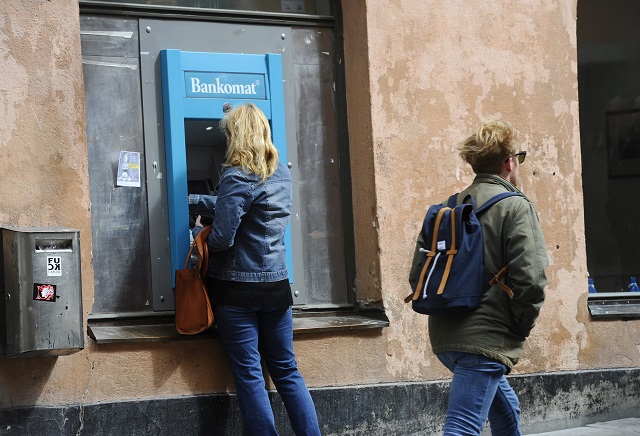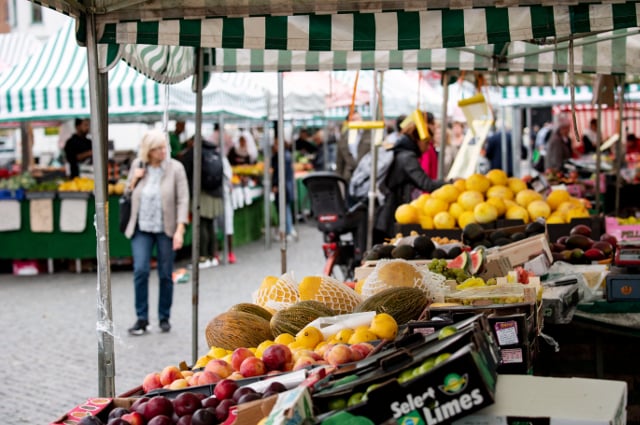Booze, food and clothes: How does Sweden's cost of living compare to the rest of Europe?

How does the cost of living in Sweden compare to the rest of Europe? The Scandinavian country has a reputation for high prices, but new EU data shows that in some areas you can get a very good deal in Sweden. The Local has broken down the statistics, and added in some of our own tried and tested money-saving tips.
Eurostat produced an interactive comparison site so users can get a rough idea of which countries in Europe and the EEA (Norway, Iceland, Switzerland) are more expensive than others in terms of the consumer costs of various products.
Overall, Sweden was ranked eighth out of the 31 countries for cost of living, with a price level index of 119 percent the EU average.
Price level indices (PLIs) are created using the price of a "basket" of goods compared across different places, with a PLI of 100 (in this case, that of the EU) used as a reference point. So that basket of typical goods was found to be 19 percent more expensive in Sweden than the EU-wide average.
MANAGING MONEY IN SWEDEN:
-
Sweden Q&A: Ten key questions to help you plan your pension
-
Nine things to know about your Swedish tax return
-
Essential guide: How to set up your first bank account in Sweden

Photo: Fredrik Sandberg/TT
Sweden was the Nordic country with the lowest cost of living according to the new data: Iceland was top of the rankings, with a PLI of 156, while Norway and Denmark took the third and fourth spots with 148 and 138 respectively. Finland also had a higher index than Sweden, at 123.
The other countries judged to have a higher cost of living than Sweden were Switzerland, Ireland, and Luxembourg, while the UK was just slightly cheaper with a PLI of 117.
The EU's statistics office didn't provide actual figures for the average price of products in each country, nor does it account for regional differences within countries or take into account differences in average salaries. But it gives some insight into which products are more or less expensive than the EU average in Sweden, and reveals that it's not the case that Sweden has above-average prices in every category.
Here's a look at how the country measures up.
Food
Sweden was the ninth priciest country in the survey for food, a category which included a variety of groceries but not dining out. Swedish prices were 18 percent higher than the EU-wide average, although prices in the other Nordic countries were even more: 61.4 percent above average in Norway, 49.8 percent above average in Iceland, 30.3 percent above average in Denmark, and 19.3 percent above average in Finland.
When it came to restaurants and hotels, the contrast was even starker. Sweden's prices in this category were 38.7 percent higher than the average. This figure was only outdone by Iceland, Norway, Switzerland and Denmark, while fellow Nordic country Finland followed close behind Sweden.

Heading to a market is a way to save money on fruit and veg. Photo: Johan Nilsson/TT
The Local's tip for budget-conscious foodies is to make the most of supermarket and cafe loyalty cards and apps such as The Fork (offering discounts on restaurants in Swedish cities) and Karma (where you can buy food close to its use-by date for an often hefty discount).
To save on hotels, consider a rural staycation in some of the cabins available along Sweden's scenic hiking trails, which are often free or very cheap. Or even better: find a friend with a summer house! And if you're a member of a union, there are often deals that allow you to rent holiday accommodation cheaply through them.
MONEY-SAVING TIPS:
-
Members' guide: How to save money despite living in Sweden
-
Know your consumer rights when shopping in Sweden
-
Six money-saving hacks for students in Sweden
-
Get money back: Don't miss out on these Swedish tax deductions
-
How to save money if you're under 26 in Sweden
Alcohol and tobacco
Of the 31 countries, Sweden was the sixth highest ranked in the category with prices 26.5 percent above the average, although its placement below the UK and Ireland might come as a surprise to some readers.
Sales of beverages over 3.5 percent alcohol volume are strictly regulated in Sweden and these drinks can only be bought at state monopoly Systembolaget, which is banned from offering discounts or special offers. But Sweden's prices were significantly lower than those of neighbouring Norway, where alcohol and tobacco prices were a huge 126.1 percent above the average.
Clothes and shoes
Sweden ranked fourth most expensive for clothes, footwear and accessories, outdone only by Iceland, Denmark, and Norway. In this category, Swedish prices were 26 percent higher than the European average.
Our tip to beat the high price tags: check out some of the country's many flea markets and secondhand shops, such as Röda Korset, Stadsmissionen and Myrorna, for an eco-friendly style bargain.
READ ALSO: 15 Stockholm vintage shops to lose yourself in
 Photo: Faramarz Gosheh/imagebank.sweden.se
Photo: Faramarz Gosheh/imagebank.sweden.se
Housing
When it comes to rentals, maintenance, and running costs such as electricity and water, Sweden is surprisingly affordable, according to Eurostat.
Prices were only 6 percent above the EEA average, and much less expensive than the other Nordic countries. There was a clear north-south divide across the continent in this category: Switzerland, Ireland and the UK were the countries with the highest priced housing, while Luxembourg, the Netherlands, Belgium, France and Germany were all costlier than Sweden.
In order to keep your housing costs low as an international in Sweden, make sure you know your rights as a renter to avoid being ripped off by the unscrupulous landlords who might try to take advantage of the country's housing shortage. Even if you're subletting, there are rules about how much you can be charged and there are systems in place to claim back some of your money if you've been charged an unreasonable rate.
READ MORE: How to avoid being ripped off when you're renting in Sweden
Furniture
Sweden is the home of affordable flat-pack giant Ikea, so perhaps it's not a surprise that this is one of the areas where you're likely to find a bargain in Sweden. Furniture and carpet prices were only 2.4 percent above the average.
READ ALSO:
-
Does Sweden's tax system really screw the rich?
-
From frugality to fika: How Ikea exported a certain image of Sweden
-
Your ultimate guide to the best shopping spots in Stockholm
Transport
The cost of personal transport (cars, motorcycles and bicycles) in Sweden was 8.2 percent below the European average, making it the category where you get the best deal. All the other Nordic countries were above the average, with Denmark topping the ranking with costs 40.5 percent above average.
Transport services (including by rail, road, air and sea) were above the European average, but only by 0.7 percent. Once again, this was significantly less than in the other Nordics. Iceland came top of the table with transport service costs 44.5 percent above the average.

Photo: Anders Wiklund/TT
Communications and leisure
Postal services, phones, and other communication services are relatively expensive in Sweden, at 118.3 percent above average.
And the wide-ranging category of 'leisure' included package holidays, gardens and pets, newspapers and books, and more, and Sweden was revealed to put a high price-tag on free time, with the cost calculated as 23.5 percent higher than the EU average.
But there are savings to be made. Many Swedish companies offer employees a friskvårdsbidrag (contribution), which means you can have gym memberships or other sporting activities subsidized by work – and a lot of employees entitled to this subsidy forget to use it. Don't forget other free services offered by the municipality, from libraries to free rentals of skis and ice skates in winter.
Comments
See Also
Eurostat produced an interactive comparison site so users can get a rough idea of which countries in Europe and the EEA (Norway, Iceland, Switzerland) are more expensive than others in terms of the consumer costs of various products.
Overall, Sweden was ranked eighth out of the 31 countries for cost of living, with a price level index of 119 percent the EU average.
Price level indices (PLIs) are created using the price of a "basket" of goods compared across different places, with a PLI of 100 (in this case, that of the EU) used as a reference point. So that basket of typical goods was found to be 19 percent more expensive in Sweden than the EU-wide average.
MANAGING MONEY IN SWEDEN:
- Sweden Q&A: Ten key questions to help you plan your pension
- Nine things to know about your Swedish tax return
- Essential guide: How to set up your first bank account in Sweden

Photo: Fredrik Sandberg/TT
Sweden was the Nordic country with the lowest cost of living according to the new data: Iceland was top of the rankings, with a PLI of 156, while Norway and Denmark took the third and fourth spots with 148 and 138 respectively. Finland also had a higher index than Sweden, at 123.
The other countries judged to have a higher cost of living than Sweden were Switzerland, Ireland, and Luxembourg, while the UK was just slightly cheaper with a PLI of 117.
The EU's statistics office didn't provide actual figures for the average price of products in each country, nor does it account for regional differences within countries or take into account differences in average salaries. But it gives some insight into which products are more or less expensive than the EU average in Sweden, and reveals that it's not the case that Sweden has above-average prices in every category.
Here's a look at how the country measures up.
Food
Sweden was the ninth priciest country in the survey for food, a category which included a variety of groceries but not dining out. Swedish prices were 18 percent higher than the EU-wide average, although prices in the other Nordic countries were even more: 61.4 percent above average in Norway, 49.8 percent above average in Iceland, 30.3 percent above average in Denmark, and 19.3 percent above average in Finland.
When it came to restaurants and hotels, the contrast was even starker. Sweden's prices in this category were 38.7 percent higher than the average. This figure was only outdone by Iceland, Norway, Switzerland and Denmark, while fellow Nordic country Finland followed close behind Sweden.

Heading to a market is a way to save money on fruit and veg. Photo: Johan Nilsson/TT
The Local's tip for budget-conscious foodies is to make the most of supermarket and cafe loyalty cards and apps such as The Fork (offering discounts on restaurants in Swedish cities) and Karma (where you can buy food close to its use-by date for an often hefty discount).
To save on hotels, consider a rural staycation in some of the cabins available along Sweden's scenic hiking trails, which are often free or very cheap. Or even better: find a friend with a summer house! And if you're a member of a union, there are often deals that allow you to rent holiday accommodation cheaply through them.
MONEY-SAVING TIPS:
- Members' guide: How to save money despite living in Sweden
- Know your consumer rights when shopping in Sweden
- Six money-saving hacks for students in Sweden
- Get money back: Don't miss out on these Swedish tax deductions
- How to save money if you're under 26 in Sweden
Alcohol and tobacco
Of the 31 countries, Sweden was the sixth highest ranked in the category with prices 26.5 percent above the average, although its placement below the UK and Ireland might come as a surprise to some readers.
Sales of beverages over 3.5 percent alcohol volume are strictly regulated in Sweden and these drinks can only be bought at state monopoly Systembolaget, which is banned from offering discounts or special offers. But Sweden's prices were significantly lower than those of neighbouring Norway, where alcohol and tobacco prices were a huge 126.1 percent above the average.
Clothes and shoes
Sweden ranked fourth most expensive for clothes, footwear and accessories, outdone only by Iceland, Denmark, and Norway. In this category, Swedish prices were 26 percent higher than the European average.
Our tip to beat the high price tags: check out some of the country's many flea markets and secondhand shops, such as Röda Korset, Stadsmissionen and Myrorna, for an eco-friendly style bargain.
READ ALSO: 15 Stockholm vintage shops to lose yourself in
 Photo: Faramarz Gosheh/imagebank.sweden.se
Photo: Faramarz Gosheh/imagebank.sweden.se
Housing
When it comes to rentals, maintenance, and running costs such as electricity and water, Sweden is surprisingly affordable, according to Eurostat.
Prices were only 6 percent above the EEA average, and much less expensive than the other Nordic countries. There was a clear north-south divide across the continent in this category: Switzerland, Ireland and the UK were the countries with the highest priced housing, while Luxembourg, the Netherlands, Belgium, France and Germany were all costlier than Sweden.
In order to keep your housing costs low as an international in Sweden, make sure you know your rights as a renter to avoid being ripped off by the unscrupulous landlords who might try to take advantage of the country's housing shortage. Even if you're subletting, there are rules about how much you can be charged and there are systems in place to claim back some of your money if you've been charged an unreasonable rate.
READ MORE: How to avoid being ripped off when you're renting in Sweden
Furniture
Sweden is the home of affordable flat-pack giant Ikea, so perhaps it's not a surprise that this is one of the areas where you're likely to find a bargain in Sweden. Furniture and carpet prices were only 2.4 percent above the average.
READ ALSO:
- Does Sweden's tax system really screw the rich?
- From frugality to fika: How Ikea exported a certain image of Sweden
- Your ultimate guide to the best shopping spots in Stockholm
Transport
The cost of personal transport (cars, motorcycles and bicycles) in Sweden was 8.2 percent below the European average, making it the category where you get the best deal. All the other Nordic countries were above the average, with Denmark topping the ranking with costs 40.5 percent above average.
Transport services (including by rail, road, air and sea) were above the European average, but only by 0.7 percent. Once again, this was significantly less than in the other Nordics. Iceland came top of the table with transport service costs 44.5 percent above the average.

Photo: Anders Wiklund/TT
Communications and leisure
Postal services, phones, and other communication services are relatively expensive in Sweden, at 118.3 percent above average.
And the wide-ranging category of 'leisure' included package holidays, gardens and pets, newspapers and books, and more, and Sweden was revealed to put a high price-tag on free time, with the cost calculated as 23.5 percent higher than the EU average.
But there are savings to be made. Many Swedish companies offer employees a friskvårdsbidrag (contribution), which means you can have gym memberships or other sporting activities subsidized by work – and a lot of employees entitled to this subsidy forget to use it. Don't forget other free services offered by the municipality, from libraries to free rentals of skis and ice skates in winter.
Join the conversation in our comments section below. Share your own views and experience and if you have a question or suggestion for our journalists then email us at [email protected].
Please keep comments civil, constructive and on topic – and make sure to read our terms of use before getting involved.
Please log in here to leave a comment.